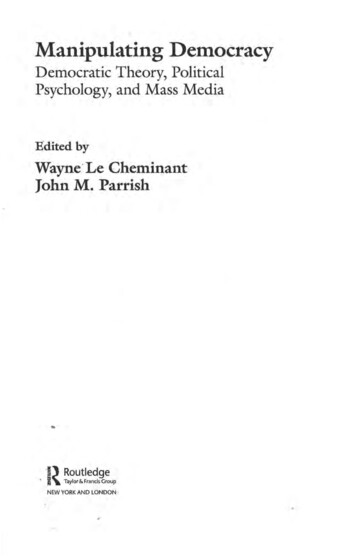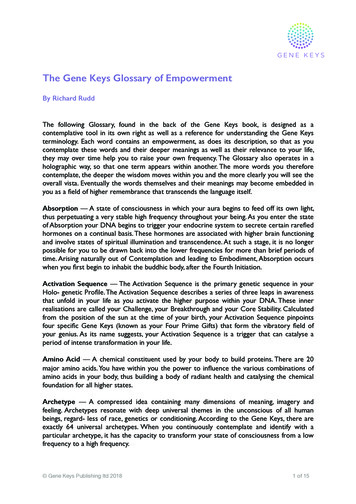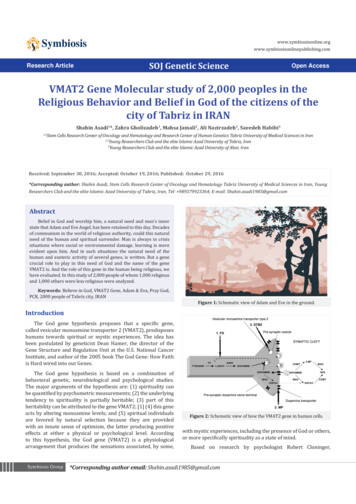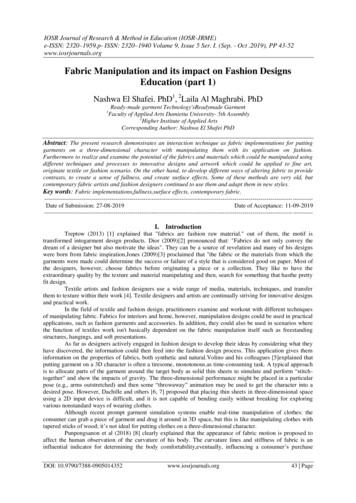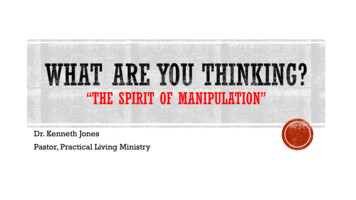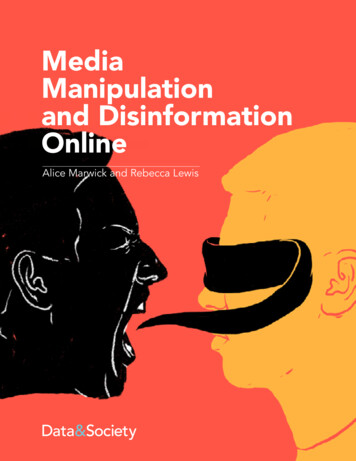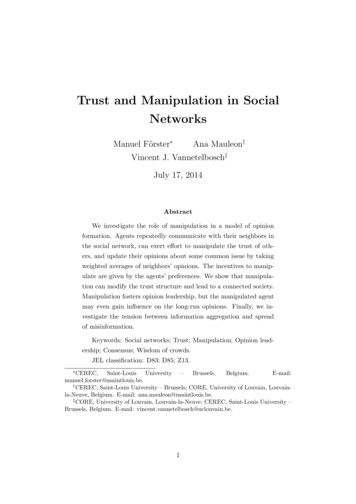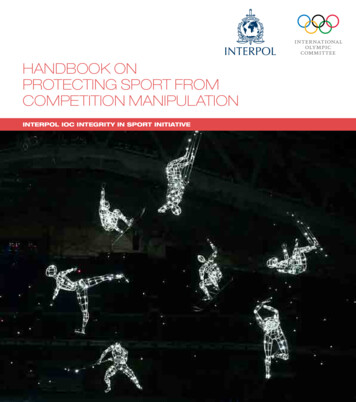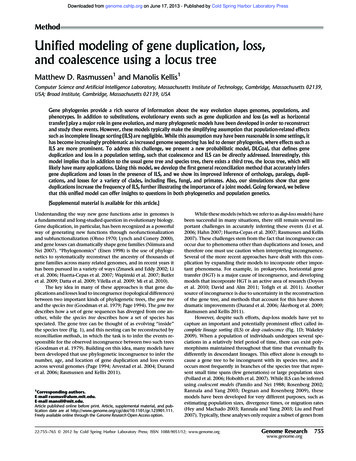
Transcription
Principles of Gene Manipulationand Genomics
Principles of GeneManipulation andGenomicsS EVENTH EDITIONS.B. Primrose and R.M. Twyman
2006 Blackwell PublishingBLACKWELL PUBLISHING350 Main Street, Malden, MA 02148-5020, USA9600 Garsington Road, Oxford OX4 2DQ, UK550 Swanston Street, Carlton, Victoria 3053, AustraliaThe rights of Sandy Primrose and Richard Twyman to be identified as the Authors of this Work havebeen asserted in accordance with the UK Copyright, Designs, and Patents Act 1988.All rights reserved. No part of this publication may be reproduced, stored in a retrieval system, ortransmitted, in any form or by any means, electronic, mechanical, photocopying, recording orotherwise, except as permitted by the UK Copyright, Designs, and Patents Act 1988, without the priorpermission of the publisher.This material was originally published in two separate volumes: Principles of Gene Manipulation, 6thedition (2001) and Principles of Genetic Analysis and Genomics, 3rd edition (2003).First published 1980Second edition published 1981Third edition published 1985Fourth edition published 1989Fifth edition published 1994Sixth edition published 2001Seventh edition published 20061 2006Library of Congress Cataloging-in-Publication DataPrimrose, S.B.Principles of gene manipulation and genomics / S.B. Primrose and R.M. Twyman.—7th ed.p. ; cm.Rev. ed. of: Principles of gene manipulation. 6th ed. 2001 and: Principles of genome analysis andgenomics / Sandy B. Primrose, Richard M. Twyman. 3rd ed. 2003.Includes bibliographical references and index.ISBN 1-4051-3544-1 (pbk. : alk. paper) 1. Genetic engineering. 2. Genomics. 3. Genemapping. 4. Nucleotide sequence.[DNLM: 1. Genetic Engineering. 2. Base Sequence. 3. Chromosome Mapping. 4. DNA,Recombinant. 5. Genomics. QH 442 P952pa 2006] I. Twyman, Richard M. II. Primrose,S.B. Principles of gene manipulation. III. Primrose, S. B. Principles of genome analysis andgenomics. IV. Title.QH442.O42 2006660.6′5—dc222005018202A catalogue record for this title is available from the British Library.Set in 10/12.5pt Photinaby Graphicraft Limited, Hong KongPrinted and bound in the United Kingdomby TJ International, Padstow, Cornwall, UKThe publisher’s policy is to use permanent paper from mills that operate a sustainable forestry policy,and which has been manufactured from pulp processed using acid-free and elementary chlorine-freepractices. Furthermore, the publisher ensures that the text paper and cover board used have metacceptable environmental accreditation standards.For further information onBlackwell Publishing, visit our website:www.blackwellpublishing.com
ContentsPreface, xviiiAbbreviations, xx1Gene manipulation in thepost-genomics era, 1Introduction, 1Gene manipulation involves the creationand cloning of recombinant DNA, 1Recombinant DNA has opened new horizonsin medicine, 3Mapping and sequencing technologies formeda crucial link between gene manipulationand genomics, 4The genomics era began in earnest in 1995with the complete sequencing of abacterial genome, 6Genome sequencing greatly increases ourunderstanding of basic biology, 7The post-genomics era aims at the completecharacterization of cells at all levels, 7Recombinant DNA technology and genomicsform the foundation of the biotechnologyindustry, 8Outline of the rest of the book, 8Part I Fundamental Techniques of GeneManipulation2Basic techniques, 15Introduction, 15Three technical problems had to be solvedbefore in vitro gene manipulation was possibleon a routine basis, 15A number of basic techniques are commonto most gene-cloning experiments, 15Gel electrophoresis is used to separatedifferent nucleic acid molecules on the basisof their size, 16Blotting is used to transfer nucleic acidsfrom gels to membranes for further analysis, 18Southern blotting is the method used totransfer DNA from agarose gels to membranesso that the compositional properties of theDNA can be analyzed, 18Northern blotting is a variant of Southernblotting that is used for RNA analysis, 19Western blotting is used to transfer proteinsfrom acrylamide gels to membranes, 19A number of techniques have been devisedto speed up and simplify the blottingprocess, 24The ability to transform E. coli with DNA is anessential prerequisite for most experiments ongene manipulation, 24Electroporation is a means of introducing DNAinto cells without making them competent fortransformation, 25The ability to transform organisms otherthan E. coli with recombinant DNA enablesgenes to be studied in different hostbackgrounds, 25The polymerase chain reaction (PCR) hasrevolutionized the way that biologistsmanipulate and analyze DNA, 26The principle of the PCR is exceedinglysimple, 27RT-PCR enables the sequences on a mRNAmolecule to be amplified as DNA, 28The basic PCR is not efficient at amplifyinglong DNA fragments, 28The success of a PCR experiment is verydependent on the choice of experimentalvariables, 29By using special instrumentation it is possibleto make the PCR quantitative, 30There are a number of different ways ofgenerating fluorescence in quantitative PCRreactions, 31It is now possible to amplify whole genomes aswell as gene segments, 34
vi34CONTENTSCutting and joining DNA molecules, 36Cutting DNA molecules, 36Understanding the biological basis of hostcontrolled restriction and modification ofbacteriophage DNA led to the identification ofrestriction endonucleases, 36Four different types of restriction andmodification (R-M) system have beenrecognized but only one is widely used in genemanipulation, 37The naming of restriction endonucleasesprovides information about their source, 39Restriction enzymes cut DNA at sites ofrotational symmetry and different enzymesrecognize different sequences, 39The G C content of a DNA molecule affects itssusceptibility to different restrictionendonucleases, 41Simple DNA manipulations can converta site for one restriction enzyme into a sitefor another enzyme, 41Methylation can reduce the susceptibilityof DNA to cleavage by restrictionendonucleases and the efficiencyof DNA transformation, 42It is important to eliminate restriction systemsin E. coli strains used as hosts for recombinantDNA, 43The success of a cloning experiment iscritically dependent on the quality of anyrestriction enzymes that are used, 43Joining DNA molecules, 44The enzyme DNA ligase is the key to joiningDNA molecules in vitro, 44Adaptors and linkers are short doublestranded DNA molecules that permit differentcleavage sites to be interconnected, 48Homopolymer tailing is a general method forjoining DNA molecules that has specialuses, 49Special methods are often required if DNAproduced by PCR amplification is to becloned, 49DNA molecules can be joined without DNAligase, 50Amplified DNA can be cloned using in vitrorecombination, 50Basic biology of plasmid and phagevectors, 55Plasmid biology and simple plasmidvectors, 55The host range of plasmids is determined bythe replication proteins that they encode, 57The number of copies of a plasmid in a cellvaries between plasmids and is determined bythe regulatory mechanisms controllingreplication, 57The stable maintenance of plasmids incells requires a specific partitioningmechanism, 59Plasmids with similar replication andpartitioning systems cannot be maintained inthe same cell, 59The purification of plasmid DNA, 59Good plasmid cloning vehicles share a numberof desirable features, 61pBR322 is an early example of a widely used,purpose-built cloning vector, 62Example of the use of plasmid pBR322 as avector: isolation of DNA fragments whichcarry promoters, 64A large number of improved vectors havebeen derived from pBR322, 64Bacteriophage λ , 66The genetic organization of bacteriophage λfavors its subjugation as a vector, 66Bacteriophage λ has sophisticated controlcircuits, 66There are two basic types of phage λvectors: insertional vectors andreplacement vectors, 69A number of phage λ vectors with improvedproperties have been described, 69By packaging DNA into phage λ in vitro it ispossible to eliminate the need for competentcells of E. coli, 70DNA cloning with single-stranded DNAvectors, 71Filamentous bacteriophages have a number ofunique properties that make them suitable asvectors, 72Vectors with single-stranded DNA genomeshave specialist uses, 72Phage M13 has been modified to make it abetter vector, 725Cosmids, phasmids, and other advancedvectors, 75Introduction, 75Vectors for cloning large fragments ofDNA, 75Cosmids are plasmids that can be packagedinto bacteriophage λ particles, 75
ContentsBACs and PACs are vectors that can carrymuch larger fragments of DNA than cosmidsbecause they do not have packagingconstraints, 76Recombinogenic engineering(recombineering) simplifies the cloning ofDNA, particularly with high-molecularweight constructs, 79A number of factors govern the choice ofvector for cloning large fragments of DNA, 81Specialist-purpose vectors, 81M13-based vectors can be used to makesingle-stranded DNA suitable forsequencing, 81Expression vectors enable a cloned gene to beplaced under the control of a promoter thatfunctions in E. coli, 81Specialist vectors have been developed thatfacilitate the production of RNA probes andinterfering RNA, 82Vectors with strong, controllable promotersare used to maximize synthesis of cloned geneproducts, 85Purification of a cloned gene product can befacilitated by use of purification tags, 87Vectors are available that promotesolubilization of expressed proteins, 92Proteins that are synthesized with signalsequences are exported from the cell, 93The Gateway system is a highly efficientmethod for transferring DNA fragments to alarge number of different vectors, 94Putting it all together: vectors withcombinations of features, 946Gene-cloning strategies, 96Introduction, 96Genomic DNA libraries are generatedby fragmenting the genome and cloningoverlapping fragments in vectors, 97The first genomic libraries were cloned insimple plasmid and phage vectors, 97More sophisticated vectors have beendeveloped to facilitate genomic libraryconstruction, 99Genomic libraries for higher eukaryotesare usually constructed using highcapacity vectors, 101The PCR can be used as an alternative togenomic DNA cloning, 101Long PCR uses a mixture of enzymes to amplifylong DNA templates, 102viiFragment libraries can be prepared frommaterial that is unsuitable for conventionallibrary cloning, 102Complementary DNA (cDNA) libraries aregenerated by the reverse transcription ofmRNA, 102cDNA is representative of the mRNApopulation, and therefore reflects mRNAlevels and the diversity of splice isoforms inparticular tissues, 102The first stage of cDNA library construction isthe synthesis of double-stranded DNA usingmRNA as the template, 105Obtaining full-length cDNA for cloning can bea challenge, 107The PCR can be used as an alternative tocDNA cloning, 110Full-length cDNA cloning is facilitated by therapid amplification of cDNA ends (RACE), 111Many different strategies are availablefor library screening, 111Both genomic and cDNA libraries can bescreened by hybridization, 111Probes are designed to maximize the chancesof recovering the desired clone, 113The PCR can be used as an alternative tohybridization for the screening of genomicand cDNA libraries, 115More diverse strategies are available for thescreening of expression libraries, 116Immunological screening uses specificantibodies to detect expressed gene products, 116Southwestern and northwestern screening areused to detect clones encoding nucleic acidbinding proteins, 117Functional cloning exploits the biochemical orphysiological activity of the gene product, 119Positional cloning is used when there is nobiological information about a gene, but itsposition can be mapped relative to other genesor markers, 121Difference cloning exploits differences inthe abundance of particular DNAfragments, 121Library-based approaches may involvedifferential screening or the creation ofsubtracted libraries enriched for differentiallyrepresented clones, 122Differentially expressed genes can also beidentified using PCR-based methods, 122Representational difference analysis is a PCRbased subtractive-cloning procedure, 124
viii78CONTENTSSequencing genes and short stretchesof DNA, 126The commonest method of DNA sequencingis Sanger sequencing (also known as chainterminator or dideoxy sequencing), 126The original Sanger method has been greatlyimproved by a number of experimentalmodifications, 128It is possible to automate DNA sequencing byreplacing radioactive labels with fluorescentlabels, 130DNA sequencing throughput can be greatlyincreased by replacing slab gels with capillaryarray electrophoresis, 131The accuracy of automated DNA sequencingcan be determined with basecallingalgorithms, 131Different strategies are required dependingon the complexity of the DNA to besequenced, 132Alternatives to Sanger sequencing have beendeveloped and are particularly useful forresequencing of DNA, 134Pyrosequencing permits sequence analysisin real time, 134It is possible to sequence DNA byhybridization using microarrays, 136Massively parallel signature sequencingcan be used to monitor RNAabundance, 140Methods are being developed for sequencingsingle DNA molecules, 140Changing genes: site-directedmutagenesis and proteinengineering, 141Introduction, 141Primer extension (the single-primer method)is a simple method for site-directedmutation, 141The single-primer method has a number ofdeficiencies, 142Methods have been developed thatsimplify the process of making allpossible amino acid substitutions ata selected site, 143The PCR can be used for site-directedmutagenesis, 144Methods are available to enable mutations tobe introduced randomly throughout a targetgene, 146Altered proteins can be produced byinserting unusual amino acids duringprotein synthesis, 147Phage display can be used to facilitate theselection of mutant peptides, 148Cell-surface display is a more versatilealternative to phage display, 149Protein engineering, 150A number of different methods of geneshuffling have been developed, 153Chimeric proteins can be produced in theabsence of gene homology, 1549Bioinformatics, 157Introduction, 157Databases are required to store andcross-reference large biologicaldatasets, 158The primary nucleotide sequence databasesare repositories for annotated nucleotidesequence data, 158SWISS-PROT and TrEMBL are databases ofannotated protein sequences, 158The Protein Databank is the main repositoryfor protein structural information, 160Secondary sequence databases pull outcommon features of protein sequencesand structures, 160Other databases cover a variety of usefultopics, 163Sequence analysis is based on alignmentscores, 163Algorithms for pairwise similarity searchingfind the best alignment between pairs ofsequences, 164Multiple alignments allow importantfeatures of gene and protein families to beidentified, 166Sequence analysis of genomic DNAinvolves the de novo identification ofgenes and other features, 166Genes in prokaryotic DNA can often be foundby six-frame translation, 166Algorithms have been developed that findgenes automatically, 168Additional algorithms are necessary to findnon-coding RNA genes and regulatoryelements, 171Several in silico methods are availablefor the functional annotation ofgenes, 173
ContentsSpecialist vectors have been developed thatpermit controlled expression in B. subtilis andother low-GC hosts, 194Vectors have been developed that facilitatesecretion of foreign proteins fromB. subtilis, 195As an aid to understanding gene function inB. subtilis, vectors have been developed fordirected gene inactivation, 195The mechanism whereby B. subtilis istransformed with plasmid DNA facilitates theordered assembly of dispersed genes, 196A variety of different methods can be used totransform high-GC organisms such as thestreptomycetes, 196Most of the vectors used with streptomycetesare derivatives of endogenous plasmids andbacteriophages, 199Cloning in Archaea, 200Caution must be exercised when usingpurely in silico methods to annotategenomes, 175Sequencing also provides new data formolecular phylogenetics, 175Part II Manipulating DNA in Microbes,Plants, and Animals10 Cloning in bacteria other thanEscherichia coli, 179Introduction, 179Many bacteria are naturally competentfor transformation, 179Recombinant DNA needs to replicate or beintegrated into the chromosome in newhosts, 183Recombinant DNA can integrate into thechromosome in different ways, 183Cloning in Gram-negative bacteria otherthan E. coli, 185Vectors derived from the IncQ-group plasmidRSF1010 are not self-transmissible, 185Mini-versions of the IncP-group plasmids havebeen developed as conjugative broad-hostrange vectors, 186Vectors derived from the broad-host-rangeplasmid Sa are used mostly with Agrobacteriumtumefaciens, 187pBBR1 is another plasmid that has beenused to develop broad-host-range cloningvectors, 188Cloned DNA can be shuttled betweenhigh-copy-number and low-copy-numbervectors, 188Proper transcriptional analysis of a clonedgene requires that it is present on thechromosome, 188Cloning in Gram-positive bacteria, 189Many of the cloning vectors used withBacillus subtilis and other low-GC bacteriaare derived from plasmids found inStaphylococcus aureus, 190The mode of plasmid replication canaffect the stability of cloning vectors inB. subtilis, 191Compared with E. coli, B. subtilis has additionalrequirements for efficient transcription andtranslation and this can prevent the expressionof genes from Gram-negative organisms inones that are Gram-positive, 194ix11Cloning in Saccharomyces cerevisiae andother fungi, 202There are a number of reasons for cloningDNA in S. cerevisiae, 202Fungi are not naturally transformable andspecial methods are required to introduceexogenous DNA, 202Exogenous DNA that is not carried on a vectorcan only be maintained by integration into achromosome, 203Different kinds of vector have been developedfor use in S. cerevisiae, 204The availability of different kinds of vectoroffers yeast geneticists great flexibility, 205Recombinogenic engineering can beused to move genes from one vector toanother, 207Yeast promoters are more complex thanbacterial promoters, 208Promoter systems have been developed tofacilitate overexpression of recombinantproteins in yeast, 209A number of specialist multi-purposevectors have been developed for usein yeast, 211Heterologous proteins can be synthesizedas fusions for display on the cell surface ofyeast, 212The methylotrophic yeast Pichia pastoris isparticularly suited to high-level expressionof recombinant proteins, 212
xCONTENTSCloning and manipulating largefragments of DNA, 213Yeast artificial chromosomes can be used toclone very large fragments of DNA, 213Classical YACs have a number of deficienciesas vectors, 213Circular YACs have a number of advantagesover classical YACs, 214Transformation-associated recombination(TAR) cloning in yeast permits selectiveisolation of large chromosomalfragments, 21412 Gene transfer to animal cells, 218Introduction, 218There are four major strategies for genetransfer to animal cells, 218There are several chemical transfectiontechniques for animal cells but all arebased on similar principles, 219The calcium phosphate method involves theformation of a co-precipitate which is taken upby endocytosis, 219Transfection with polyplexes is more efficientbecause of the uniform particle size, 220Transfection can also be achieved usingliposomes and lipoplexes, 222Physical transfection techniques havediverse mechanisms, 222Electroporation and ultrasound createtransient pores in the cell, 222Other physical transfection methods pierce thecell membrane and introduce DNA directlyinto the cell, 223Cells can be transfected with eitherreplicating or non-replicating DNA, 223Three types of selectable marker have beendeveloped for animal cells, 224Endogenous selectable markers arealready present in the cellular genome, andmutant cell lines are required when they areused, 224There is no competing activity for dominantselectable markers, 225Some marker genes facilitate stepwisetransgene amplification, 226Plasmid vectors for the transfection ofanimal cells contain modules frombacterial and animal genes, 228Non-replicating plasmid vectors persistfor a short time in an extrachromosomalstate, 228Runaway polyomavirus replicons facilitate theaccumulation of large amounts of protein in ashort time, 230BK and BPV replicons facilitate episomalreplication, but the plasmids tend to bestructurally unstable, 231Replicons based on Epstein–Barr virusfacilitate long-term transgene stability, 236DNA can be delivered to animal cells usingbacterial vectors, 236Viruses are also used as gene-transfervectors, 238Adenovirus vectors are useful for short-termtransgene expression, 238Adeno-associated virus vectors integrate intothe host-cell genome, 239Baculovirus vectors promote high-leveltransgene expression in insect cells, but canalso infect mammalian cells, 240Herpesvirus vectors are latent in many celltypes and may promote long-term transgeneexpression, 243Retrovirus vectors integrate efficiently intothe host-cell genome, 243Retroviral vectors are often replicationdefective and self-inactivating, 244There are special considerations for theconstruction of lentiviral vectors, 245Sindbis virus and Semliki forest virus vectorsreplicate in the cytoplasm, 246Vaccinia and other poxvirus vectors arewidely used for vaccine delivery, 248Summary of expression systems foranimal cells, 24913 Genetic manipulation of animals, 251Introduction, 251Three major methods have been developedfor the production of transgenic mice, 251Pronuclear microinjection involves the directtransfer of DNA into the male pronucleus ofthe fertilized mouse egg, 252Recombinant retroviruses can be used totransduce early embryos prior to theformation of the germline, 253Transgenic mice can be produced by thetransfection of ES cells followed by the creationof chimeric embryos, 254ES cells can be used for gene targeting inmice, 255Gene-targeting vectors may disrupt genes byinsertion or replacement, 256
ContentsSophisticated selection strategies have beendeveloped to isolate rare gene-targetingevents, 257Two rounds of gene targeting allow theintroduction of subtle mutations, 257Recent advances in gene-targetingtechnology, 258Applications of genetically modifiedmice, 258Applications of transgenic mice, 258Yeast artificial chromosome (YAC)transgenic mice, 262Applications of gene targeting, 262Standard transgenesis methods are moredifficult to apply in other mammals andbirds, 263Intracytoplasmic sperm injection uses spermas passive carriers of recombinant DNA, 264Nuclear transfer technology can be used toclone animals, 264Gene transfer to Xenopus can result intransient expression or germlinetransformation, 266Xenopus oocytes can be used as a heterologousexpression system, 266Xenopus oocytes can be used for functionalexpression cloning, 266Transient gene expression in Xenopus embryosis achieved by DNA or mRNA injection, 267Transgenic Xenopus embryos can be producedby restriction enzyme-mediated integration, 267Gene transfer to fish is generally carriedout by microinjection, but other methodsare emerging, 268Gene transfer to fruit flies involves themicroinjection of DNA into the poleplasma, 269P elements are used to introduce DNA into theDrosophila germline, 269Natural P elements have been developed intovectors for gene transfer, 269Gene targeting in Drosophila has been achievedusing a combination of homologous and sitespecific recombination, 27114 Gene transfer to plants, 274Introduction, 274Plant tissue culture is required for mosttransformation procedures, 274Callus cultures are established underconditions that maintain cells in anundifferentiated state, 274xiCallus cultures can be broken up to form cellsuspensions, which can be maintained inbatches, 275Protoplasts are usually derived fromsuspension cells and can be idealtransformation targets, 276Cultures can be established directly from therapidly dividing cells of meristematic tissuesor embryos, or from haploid cells, 276Regeneration of fertile plants can occurthrough organogenesis or somaticembryogenesis, 276There are four major strategies for genetransfer to plant cells, 277Agrobacterium-mediatedtransformation, 277Agrobacterium tumefaciens is a plant pathogenthat induces the formation of tumors, 277The ability to induce tumors is conferred by aTi-plasmid found only in virulentAgrobacterium strains, 278A short segment of DNA, the T-DNA, istransferred to the plant genome, 280Disarmed Ti-plasmid derivatives can be used asplant gene-transfer vectors, 281Binary vectors separate the T-DNA andthe genes required for T-DNA transfer,allowing transgenes to be cloned in smallplasmids, 285Agrobacterium-mediated transformation canbe achieved using a simple experimentalprotocol in many dicots, 287Monocots were initially recalcitrant toAgrobacterium-mediated transformation, butit is now possible to transform certain varietiesof many cereals using this method, 288Binary vectors have been modified totransfer large segments of DNA into theplant genome, 289Agrobacterium rhizogenes is used totransform plant roots and producehairy-root cultures, 289Direct DNA transfer to plants, 290Transgenic plants can be regenerated fromtransformed protoplasts, 290Particle bombardment can be used totransform a wide range of plant species, 291Other direct DNA transfer methods have beendeveloped for intact plant cells, 292Direct DNA transfer is also used for chloroplasttransformation, 292Gene targeting in plants, 293
xiiCONTENTSIn planta transformation minimizes oreliminates the tissue culture steps usuallyneeded for the generation of transgenicplants, 293Plant viruses can be used as episomalexpression vectors, 294The first plant viral vectors were based on DNAviruses because of their small and simplegenomes, 294Most plant virus expression vectors are basedon RNA viruses because they can accept largertransgenes than DNA viruses, 29615 Advanced transgenic technology, 299Introduction, 299Inducible expression systems allowtransgene expression to be controlled byphysical stimuli or the application ofsmall chemical modulators, 299Some naturally occurring induciblepromoters can be used to control transgeneexpression, 299Recombinant inducible systems are builtfrom components that are not found in thehost animal or plant, 300The lac and tet repressor systems are basedon bacterial operons, 301The tet activator and reverse activator systemswere developed to circumvent some of thelimitations of the original tet system, 302Steroid hormones also make suitableheterologous inducers, 303Chemically induced dimerization exploits theability of a divalent ligand to bind two proteinssimultaneously, 304Not all inducible expression systems aretranscriptional switches, 306Site-specific recombination allowsprecise manipulation of the genome inorganisms where gene targeting isinefficient, 306Site-specific recombination can be used todelete unwanted transgenes, 307Site-specific recombination can be used toactivate transgene expression or switchbetween alternative transgenes, 308Site-specific recombination can facilitateprecise transgene integration, 309Site-specific recombination can facilitatechromosome engineering, 309Inducible site-specific recombinationallows the production of conditionalmutants and externally regulatedtransgene excision, 309Many strategies for gene inactivation donot require the direct modification of thetarget gene, 312Antisense RNA blocks the activity of mRNAin a stoichiometric manner, 312Ribozymes are catalytic molecules thatdestroy targeted mRNAs, 313Cosuppression is the inhibition of anendogenous gene by the presence of ahomologous sense transgene, 314RNA interference is a potent form of silencingcaused by the direct introduction of doublestranded RNA into the cell, 318Gene inhibition is also possible at theprotein level, 319Intracellular antibodies and aptamers bind toexpressed proteins and inhibit their assemblyor activity, 319Active proteins can be inhibited bydominant-negative mutants in multimericassemblies, 320Part III Genome Analysis, Genomics,and Beyond16 The organization and structure ofgenomes, 323Introduction, 323The genomes of cellular organisms varyin size over five orders of magnitude, 323Increases in genome complexity sometimes areaccompanied by increases in the complexity ofgene structure, 326Viruses and bacteria have very simplegenomes, 328Organelle DNA is a repetitivesequence, 330Chloroplast DNA structure is highlyconserved, 330Mitochondrial genome architecture variesenormously, particularly in plants andprotists, 331The organization of nuclear DNA ineukaryotes, 332The gross anatomy of chromosomes is revealedby Giemsa staining, 332Telomeres play a critical role in themaintenance of chromosomal integrity, 332Tandemly repeated sequences can be detectedin two ways, 333
ContentsTandemly repeated sequences can besubdivided on the basis of size, 335Dispersed repeated sequences are composed ofmultiple copies of two types of transposableelements, 338Retrotransposons can be divided into twogroups on the basis of transpositionmechanism and structure, 339DNA transposons are simpler thanretrotransposons, 340Transposon activity is highly variable acrosseukaryotes, 340Repeated DNA is non-randomly distributedwithin genomes, 340Eukaryotic genomes are very plastic, 341Pseudogenes are derived from repeatedDNA, 341Segmental duplications are very large,low-copy-number repeats, 341The human Y chromosome has an unusualstructure, 342Centromeres are filled with tandem repeatsand retroelements, 344Summary of structural elements of eukaryoticchromosomes, 34417 Mapping and sequencing genomes, 346Introduction, 346The first physical map of an organism madeuse of restriction fragment lengthpolymorphisms (RFLPs), 346Sequence tags are more convenient markersthan RFLPs because they do not use Southern
edition (2001) and Principles of Genetic Analysis and Genomics, 3rd edition (2003). First published 1980 Second edition published 1981 Third edition published 1985 Fourth edition published 1989 Fifth edition published 1994 Sixth edition published 2001 Seventh edition published 2006 1 20
